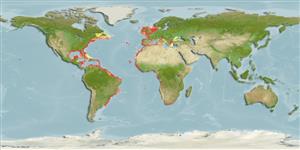>
Tetraodontiformes (Puffers and filefishes) >
Balistidae (Triggerfishes)
Etymology: Balistes: Latin, balista, -ae = crossbowman. In Greek, ballo = to throw (Ref. 45335); capriscus: Specific name 'capriscus' meaning a small goat; probably referring to its 'face' which looks like a small goat (to be confirmed)...
More on author: Gmelin.
Environment: milieu / climate zone / depth range / distribution range
Ecologia
marinhas associadas(os) a recifes; intervalo de profundidade 0 - 100 m (Ref. 7348), usually 0 - 55 m (Ref. 55172). Tropical; 58°N - 37°S, 98°W - 36°E
Western and Eastern Atlantic:
Comprimento de primeira maturação / Tamanho / Peso / Idade
Maturity: Lm 17.0, range 13 - 29.7 cm
Max length : 66.0 cm TL macho/indeterminado; (Ref. 127374); common length : 44.0 cm TL macho/indeterminado; (Ref. 47377); peso máx. publicado: 6.2 kg (Ref. 40637); idade máx. registrada: 15 anos (Ref. 107826)
Espinhos dorsais (total): 3; Raios dorsais (total): 26-29; Espinhos anais 0; Raios anais : 23 - 26. Tall, with a small mouth and plate like scales (Ref. 35388). Three faint irregular broad dark bars on body; a narrow pale transverse band on chin; small light blue spots on upper half of body and median fins, and irregular short lines ventrally (Ref. 13442).
Inhabits bays, harbors, lagoons, and seaward reefs (Ref. 9710). May drift with young at surface among Sargassum (Ref. 9710). Usually solitary or in small groups (Ref. 9710). Feeds on benthic invertebrates like mollusks and crustaceans (Ref. 4727). Oviparous (Ref. 205). Consumed mostly fresh, smoked, and dried salted. The flesh is of excellent quality. Because it is resistant to capture, it proliferates and competes for food with other species (Ref. 5377).
Adults guard the embryos nested in sand which hatched in about two days (Ref. 9778).
Smith-Vaniz, W.F., B.B. Collette and B.E. Luckhurst, 1999. Fishes of Bermuda: history, zoogeography, annotated checklist, and identification keys. American Society of Ichthyologists and Herpetologists Special Publication No. 4. 424 p. (Ref. 35505)
Status na Lista Vermelha da UICN (Ref. 130435)
Ameaça para os humanos
Reports of ciguatera poisoning (Ref. 30911)
Uso pelos humanos
Pescarias: espécies comerciais; peixe esportivo: sim; Aquário: Aquários públicos
Ferramentas
Relatórios especiais
Baixar XML
Fontes da internet
Estimates based on models
Preferred temperature (Ref.
123201): 9 - 26.2, mean 17.8 °C (based on 1432 cells).
Índice de diversidade filogenética (Ref.
82804): PD
50 = 0.5078 [Uniqueness, from 0.5 = low to 2.0 = high].
Bayesian length-weight: a=0.02089 (0.01769 - 0.02468), b=2.90 (2.85 - 2.95), in cm total length, based on LWR estimates for this species (Ref.
93245).
Nível Trófico (Ref.
69278): 4.1 ±0.2 se; based on diet studies.
Generation time: 4.0 (2.6 - 4.8) years. Estimated as median ln(3)/K based on 20
growth studies.
Resiliência (Ref.
120179): médio(a), tempo mínimo de duplicação da população 1,4 - 4,4 anos (K=0.18-0.43; tm=1).
Prior r = 0.53, 95% CL = 0.35 - 0.79, Based on 1 stock assessment.
Fishing Vulnerability (Ref.
59153): Moderate to high vulnerability (46 of 100).
Climate Vulnerability (Ref.
125649): Low to moderate vulnerability (32 of 100).
Nutrients (Ref.
124155): Calcium = 17.4 [6.5, 68.9] mg/100g; Iron = 0.507 [0.242, 1.275] mg/100g; Protein = 19.7 [18.6, 20.8] %; Omega3 = 0.212 [0.146, 0.316] g/100g; Selenium = 21.2 [8.9, 47.8] μg/100g; VitaminA = 25 [6, 111] μg/100g; Zinc = 0.5 [0.3, 0.8] mg/100g (wet weight); based on
nutrient studies.
